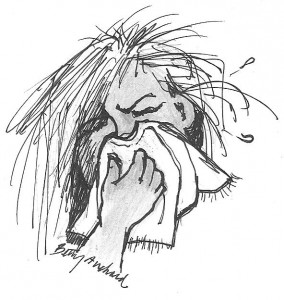 Any resident at The Home who had reached the age of eight had to take a turn doing nose rag duty. I had that job more than once. A big girl and two little girls were assigned to work together, and their task was to keep a large supply of clean cloth squares ready to be used by any kid with a snotty nose. We tore 12” squares from old, soft, worn out sheets and turned them into something new: handkerchiefs for kids with colds. The raggedy pieces were not hemmed, and loose threads hung from the edges. Some of the more creative kids pulled the threads away from each edge to make fluffy quarter-inch fringe. Mrs. Stone, the girls’ monitor, considered making fringe a useless activity. “Girls, get on with it,” she would say. “You’re taking too much time.” But fringe made the edges of the rags look nice and pulling the threads made the process a more satisfying activity, so we did it as often as we could get by with it.
Any resident at The Home who had reached the age of eight had to take a turn doing nose rag duty. I had that job more than once. A big girl and two little girls were assigned to work together, and their task was to keep a large supply of clean cloth squares ready to be used by any kid with a snotty nose. We tore 12” squares from old, soft, worn out sheets and turned them into something new: handkerchiefs for kids with colds. The raggedy pieces were not hemmed, and loose threads hung from the edges. Some of the more creative kids pulled the threads away from each edge to make fluffy quarter-inch fringe. Mrs. Stone, the girls’ monitor, considered making fringe a useless activity. “Girls, get on with it,” she would say. “You’re taking too much time.” But fringe made the edges of the rags look nice and pulling the threads made the process a more satisfying activity, so we did it as often as we could get by with it.
In the hall near the bathroom were two flour-bin type hampers that tilted out from the wall. Next to them was the dumb waiter that went clear to the basement. One hamper was labeled “clean” and the other “used.” The clean hamper was filled to the brim with freshly laundered, wrinkled squares that we could grab anytime we needed to blow. We balled a rag into a fist shape and carried it around that way. When we felt a sneeze coming on we unfolded the cloth ball quickly and searched for a fresh, dry place to blow into. We carried that lump of fabric around with us and blasted our noses into it until there were no dry spots left. Used squares were wadded into misshapen clumps before being tossed into the hamper labeled “used.” There, they dried into crispy shapes like kindergarten art projects.
Used nose rags were traps that collected germs and probably helped share our colds with every other kid who lived there. But it was unthinkable to throw them away. If we were assigned to nose rag duty, we pre-washed the crusty balls in the bathtub with Fels Naptha soap. After being rinsed and squeezed, the cloth squares were put into plastic pans and sent to the basement by the dumb waiter. There they were washed again in sudsy hot water in the Maytag, rinsed in bleach water, then pushed through the rubber rollers to squeeze out as much liquid as possible.
We hung them on the clothesline in the sunshine in small bundles caught at the corner with wooden pins that looked like little men with no faces or arms. In summer, the crude hankies dried quickly in the hot sun. In winter, they freeze-dried on the same clothesline. Mrs. Stone said that freezing the white cloths made them whiter, and I believed her because she was a grown up. When they had dried, we tossed them into the pull-out bin labeled “clean” where they were ready to be used again.
In addition to the nose rags, we shared or recycled just about everything at The Home for the Friendless: toys, combs, the bathtub, drinking glasses, and germs. Of course, we exchanged germs with family members when living at home with our parents. But at The Home for the Friendless, there were more people to share them with.
We didn’t think much about germs at the time. But we did understand the importance of the work we had to do at the home because the adults told us we were learning to be responsible. Any messes we made we had to clean up ourselves. Nose rags were just another mess, but it was one we avoided as often as possible. That’s why the threat of extra nose rag duty was an effective deterrent to bad behavior at The Home for the Friendless.
____________________________________________________________________________________________
excerpt pg 77 from The Home for the Friendless, by Betty Auchard–illustration for this blog by Betty Auchard
www.bettyauchard.com
-
Oscar Case













